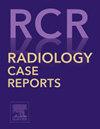乳腺血管瘤:造影剂增强超声(CEUS)在评估罕见间质病变血管性方面的附加值
Q4 Medicine
引用次数: 0
摘要
血管瘤在许多解剖部位都有描述,但在乳房中却很少发生;虽然不常见,但却是乳房中最常见的良性血管肿瘤。根据世界卫生组织的定义,它们属于间质病变的范畴,是一种发生在乳腺基质中的病变。在此,我们介绍一例乳腺血管瘤病例,患者是一名 40 岁女性,左侧乳房可触及肿块,随着时间的推移肿块慢慢增大。该病灶于 2018 年首次接受诊断性活组织检查;经过 5 年的常规超声随访后,我们小组于 2023 年使用对比增强超声(CEUS)对其进行了研究,以评估其血管化情况。根据我们的经验,我们得出结论:对于经过精心挑选、组织学证实的乳腺血管瘤病例,保守治疗和随访成像是安全的;CEUS 是一种研究血管瘤的无创方法,由于其能够提供血管信息,因此优于传统 US。对于成像不典型或临床病理特征可疑的病例,必须对血管瘤进行彻底的手术切除,以排除潜在血管肉瘤的可能性,尤其是当病变超过 2 厘米时。本文章由计算机程序翻译,如有差异,请以英文原文为准。
Haemangioma of the breast: The added value of contrast enhanced ultra-sound (CEUS) in the vascularity assessment of a rare mesenchymal lesion
Haemangiomas have been described in many anatomic locations, but occur quite rarely in the breast; although unfrequent, they are the most common benign vascular tumors of the breast. They are comprised in the cathegory of mesenchymal lesions, a spectrum of lesions that arise in the stroma of the breast as defined by WHO.
Here we present the case of a breast haemangioma in a 40-years-old woman, with history of a palpable lump in the left breast slowly increasing in size over time. The lesion first underwent diagnostic biopsy in 2018; after a 5-years follow-up with conventional ultrasound, it was studied in 2023 by our group using Contrast Enhanced Ultra-Sound (CEUS) in order to evaluate its vascularization. Basing on our experience, we conclude that in carefully selected cases of histologically proven breast haemangioma, a conservative management with follow-up imaging is safe; CEUS represents a noninvasive method for studying haemangiomas, superior than traditional US thanks to its ability to provide information about vascularity. In those cases with atypical imaging or clinical pathological suspicious characteristics, a complete surgical resection of the vascular tumor is mandatory–in order to exclude the possibility of an underlying angiosarcoma, especially when the lesion measures more than 2 cm.
求助全文
通过发布文献求助,成功后即可免费获取论文全文。
去求助
来源期刊

Radiology Case Reports
Medicine-Radiology, Nuclear Medicine and Imaging
CiteScore
1.10
自引率
0.00%
发文量
1074
审稿时长
30 days
期刊介绍:
The content of this journal is exclusively case reports that feature diagnostic imaging. Categories in which case reports can be placed include the musculoskeletal system, spine, central nervous system, head and neck, cardiovascular, chest, gastrointestinal, genitourinary, multisystem, pediatric, emergency, women''s imaging, oncologic, normal variants, medical devices, foreign bodies, interventional radiology, nuclear medicine, molecular imaging, ultrasonography, imaging artifacts, forensic, anthropological, and medical-legal. Articles must be well-documented and include a review of the appropriate literature.
 求助内容:
求助内容: 应助结果提醒方式:
应助结果提醒方式:


